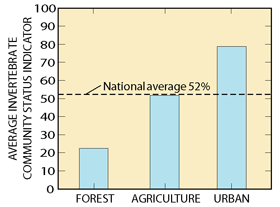MAJOR FINDINGS—Continued
Factors influencing invertebrate communities in urban streams may include elevated concentrations of PCBS, organochlorine pesticides (DDT, DDE and DDD), PAHS, and trace elements in streambed sediments. Concentrations of some of these compounds rank among the greatest in the Nation (MeNellis and others, 2001; Kroening and others, 2000). In addition to chemical characteristics, modification to stream hydrology and removal of instream habitat may contribute to degraded conditions for aquatic communities in urban streams in the Study Unit. |
Water Quality and Aquatic Biological Conditions have Characteristics Indicative of Dominant Land Uses
Sodium and chloride concentrations were greater in shallow ground water and streams in urban areas than in agricultural or forested areas. Chloride concentrations commonly exceeded the USEPA aquatic-life criteria of 230 mg/L (Mitton and Payne, 1997; Fong, 2000; Fallon and Chaplin, 2001). Elevated sodium and chloride concentrations are the result of de-icers that are applied more heavily in urban areas.
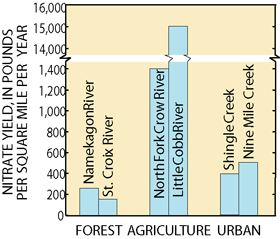 |
| Figure 10. Nitrate yields were greatest in streams draining agricultural areas in the Study Unit. |
Concentrations and yields of nutrients and suspended sediment in streams that drain agricultural areas were substantially greater than those that drain urban or forested areas (fig. 10). Increased nutrient concentrations have contributed to accelerated eutrophication and low dissolved-oxygen concentrations (Kroening, 2000), which adversely affect aquatic communities. Eutrophication has been most notable in the Minnesota River Basin. The greatest nitrate concentrations in the Minnesota River Basin were measured during rainfall runoff (Payne, 1994; Kroening and others, 2000). Exceedences of the USEPA drinking-water standard of 10 mg/L for nitrate occurred in less than 4 percent of urban and 38 percent of agricultural ground-water samples, whereas nitrate was commonly undetected (less than 0.05 mg/L) in forested areas (fig. 11). Nitrate concentrations in shallow ground water increased with agricultural intensity, particularly in unconfined sand and gravel aquifers (Hanson, 1998), suggesting that underlying deeper aquifers, typically used for drinking water, have potential to be contaminated with nitrate (fig. 11) (Fong, 2000).
 |
|
| Figure 11. Nitrate concentrations were greatest in ground water in agricultural areas of the Study Unit. |
The pesticides detected differed by land use. Herbicides were the most frequently detected in surface and ground water. Atrazine and its degradation product, deethylatrazine, were detected in all land-use settings (Fallon and others, 1997; Fong, 2000). Prometon, a herbicide used on road rights-of-way, was the most frequently detected herbicide in ground water in urban settings (Andrews and others, 1998). Organochlorine concentrations in streambed sediment were substantially greater in urban streams than in agricultural or forest streams (McNellis and others, 2001).
Volatile organic compounds were most commonly detected in urban areas. In ground water, the most frequently detected VOCs (carbon disulfide and chloromethane) were in shallow aquifers in urban areas, but at concentrations generally less than 1 µg/L (fig. 12) (Andrews and others, 1998). VOCs also were detected in ground-water samples from agricultural areas, but at concentrations and detection frequencies less than urban areas (Ruhl and others, 2000). In urban streams, the greatest concentrations of VOCs were detected following storm runoff and during winter low flows.
Trace concentrations of PCBs and DDE (a degradation product of DDT) were detected in fish throughout the Study Unit (Biedron and Helwig, 1991). PCB concentrations in common carp fillet tissue have decreased at different rates in each land-use setting since their use was discontinued in the 1970s (Durfee, 1976) (fig.13). Concentrations of these compounds were greater in fish and sediment from stream reaches near urban areas (Fallon and others, 1997; Lee and Anderson, 1998; McNellis and others, 2001).
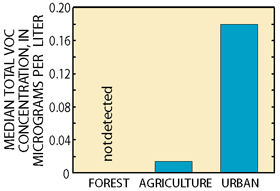 |
| Figure 12. Total volatile organic compound concentrations were greatest in ground water in urban areas in the Study Unit. |
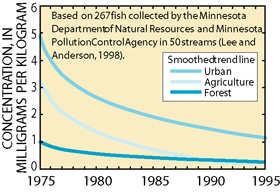 |
| Figure 13. Polychlorinated biphenyl concentrations in common carp fillets collected from streams in the Study Unit have decreased since 1975. |
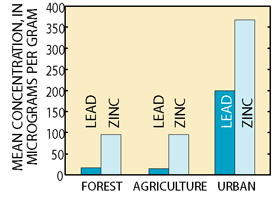 |
| Figure 14. Lead and zinc concentrations were greatest in streambed sediments in urban areas in the Study Unit. |
Streambed-sediment concentrations of lead, zinc (fig. 14), cadmium, and copper were greater in urban areas than other land-use settings (Kroening and others, 2000). In streams draining agricultural and forested areas, trace-element concentrations in streambed sediment probably reflected natural geochemistry. Mercury concentrations in fish livers were greater in streams draining land uses other than urban settings (Kroening and others, 2000). Agricultural and urban activities contribute to elevated suspended-sediment concentrations and bacteria counts in small streams. Suspended-sediment concentrations were greatest in agricultural streams.
Aquatic biological communities are affected by chemical, hydrological, and physical conditions in streams and serve as good indicators of water quality. Community composition indicated more degraded conditions in urban streams than in forest or agricultural streams (Lee and others, 1999; Talmage and others, 1999). Invertebrate communities in urban streams are composed of fewer mayflies, stoneflies, and caddisflies than streams draining agricultural and forested land (fig. 15) (Lee and others, 1999). Fish communities in urban streams were dominated by species tolerant of low dissolved-oxygen concentrations and warm temperatures (Goldstein and others, 1999; Talmage and others, 1999). Fish biomass and phytoplankton biovolume are indicators of stream productivity. The greatest fish biomass (usually in the form of species such as common carp) and phytoplankton biovolumes were measured in agricultural streams (fig. 16).
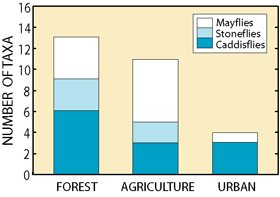 |
| Figure 15. Total number of mayflies, stoneflies and caddisflies, indicators of good water-quality conditions, was greatest in streams draining forested areas in the Study Unit. |
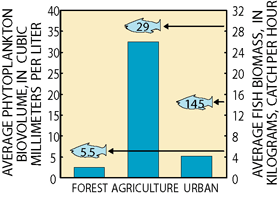 |
| Figure 16. Phytoplankton biovolume and fish biomass were greatest in streams draining agricultural areas in the Study Unit. |
Land Use Influences Water-Supply Aquifers
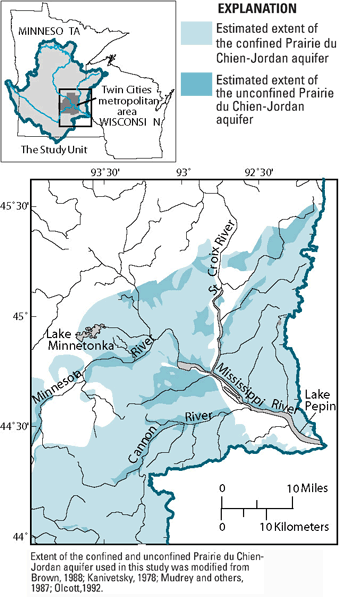 |
| Figure 17. Estimated extent of the Prairie du Chien-Jordan aquifer in part of the Study Unit. |
The Prairie du Chien-Jordan aquifer, which occurs in dolomite and sandstone of Cambrian to Ordovician age, is the principal bedrock aquifer throughout much of the Study Unit (fig. 17), supplying approximately 75 percent of the ground water withdrawn in the area for public and industrial supply. In certain areas, termed confined portion, bedrock or glacial deposits having low permeability overlie the aquifer. In other areas, termed unconfined portion, glacial sand and gravel deposits having greater permeability overlie the aquifer. The hydrogeologic characteristics of these overlying units affect the downward movement of water and contaminants from the land surface into the aquifer.
Water in the unconfined portion of the aquifer appears to be affected to a greater degree by human-related activities than water in the confined portion of the aquifer. Nitrate concentrations were greater in the unconfined portion of the aquifer. In the unconfined portion of the aquifer, nitrate in 8 percent of the wells sampled exceeded the USEPA drinking-water standard of 10 mg/L. In the confined portion of the aquifer, no samples exceeded 10 mg/L of nitrate. Phosphorus concentrations generally were about one-tenth of nitrate concentrations. In about 40 percent of water samples from confined and unconfined portions of the aquifer, concentrations of iron and manganese in water samples from confined and unconfined portions of the aquifer exceeded drinking-water guidelines.
Radon concentrations ranged from 100 to 2,700 pCi/L and exceeded the suspended USEPA drinking-water standard of 300 pCi/L in 68 percent of the water samples from the unconfined portion of the aquifer and 64 percent from the confined portion of the aquifer. Tritium concentrations in ground water indicated that water in the unconfined portion of the aquifer was recharged more recently than water in the confined portion of the aquifer.
Arsenic concentrations in the confined and unconfined portions of the aquifer ranged from less than the method reporting limit (1 µg/L) to 7 µg/L. These concentrations do not exceed the current USEPA drinking-water standard of 50 µg/L.
Seven different pesticide compounds were detected in water samples. Atrazine and its degradation product, deethylatrazine, were most frequently detected. Atrazine was detected in water from 36 percent of wells in the confined portion of the aquifer and 52 percent of wells in the unconfined portion of the aquifer. VOCs were detected in 82 percent of the water samples, but none at concentrations exceeding 1 µg/L. More VOCs were detected in water samples from the unconfined portion of the aquifer than from the confined portion.
Water Quality and Aquatic Biology of Large Rivers
Water quality and aquatic biology in the large rivers of the Study Unit (the Mississippi, Minnesota, and St. Croix) represent the cumulative quality of their tributaries. The tributaries of the Minnesota River drain primarily agricultural land, the tributaries of the St. Croix River drain primarily forested land, and the tributaries of the Mississippi River drain primarily agricultural and forested land. Because of agricultural activities and natural conditions, water in the Minnesota River contains elevated concentrations and yields of nutrients, suspended sediments, and pesticides (Fallon and others, 1997; Kroening, 2000). The aquatic biological community contains fewer invertebrate and algal taxa, but greater chlorophyll-a concentrations associated with greater nutrient concentrations (Kroening, 2000; Lee and ZumBerge, 2000) (fig. 18). In contrast, the St. Croix River and the Mississippi River upstream from the TCMA have low nutrient concentrations, relatively clear water, and low suspended-sediment and pesticide concentrations (Fallon and others, 1997; Fallon, 1998; Kroening, 2000). Downstream from the TCMA, and below the confluence of the Minnesota and St. Croix Rivers, water quality in the Mississippi River results from a complex mixture of water and chemical constituents. Concentrations of nutrients, suspended sediments, and pesticides in the Mississippi River increase at the confluence with the Minnesota River and decrease slightly, due to dilution downstream from the confluence with the St. Croix River (fig. 19) (Fallon, 1998; Kroening, 2000).
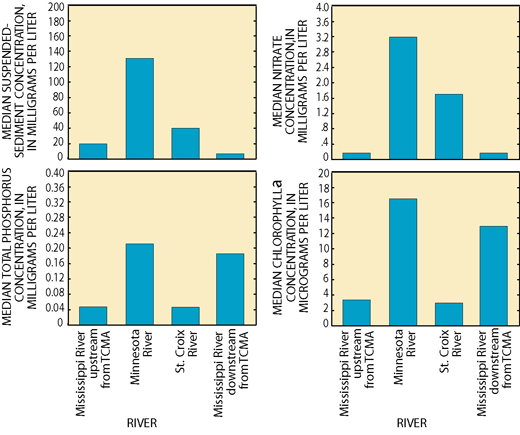 |
| Figure 18. Median concentrations of nitrate, total phosphorus, suspended sediments, and chlorophyll-a were generally lower upstream from the Twin City Metropolitan Area (TCMA) and were greatest in the Minnesota River. |
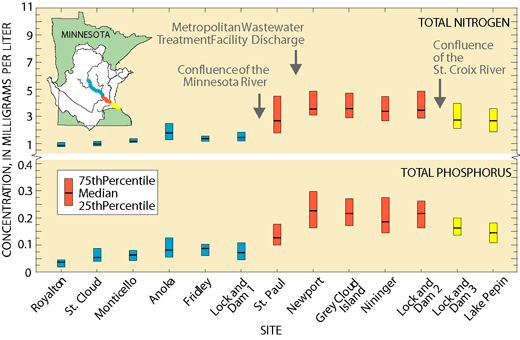 |
| Figure 19. Total nitrogen and phosphorus concentrations in the Mississippi River increase downstream from the confluence of the Minnesota River and decrease downstream from the confluence of the St. Croix River. |
Nitrate concentrations in the Mississippi and St. Croix Rivers did not exceed the USEPA drinking-water standard of 10 mg/L (Kroening, 1998a, 2000). Eleven percent of the samples from the Minnesota River near Jordan, Minn., exceeded the standard. The most noticeable trends in the Mississippi, Minnesota, and St. Croix Rivers during 1984–93 were an increase in nitrate concentrations and a decrease in total ammonia concentrations in the TCMA (fig. 20) (Kroening and Andrews, 1997). These trends were not observed at other sites. These ammonia reductions are probably the result of nitrification processes used at the three largest wastewater treatment facilities in the TCMA, which convert ammonia-nitrogen to nitrate. This process has resulted in wastewater effluents that are less toxic to fish and other aquatic life. Nitrate concentrations, however, may contribute to eutrophication.
 |
| Figure 20. Modifications in wastewater-treatment processes have changed measured total nitrate and toal ammonia nitrogen concentrations in the Mississippi River at Newport, Minn. |
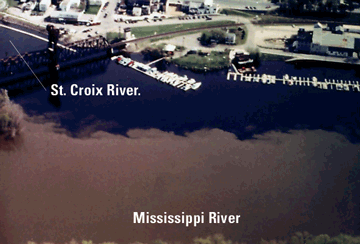 |
| Aerial view of the confluence of the St. Croix and the Mississippi Rivers. (Photograph by James R. Stark.) |
Total phosphorus concentrations in parts of the Minnesota River and in the Mississippi River downstream from the TCMA frequently exceeded the USEPA guideline of 0.1 mg/L to prevent eutrophication (Kroening, 1998b, 2000). Phosphorus concentrations and loads to the rivers originate from both point and nonpoint sources. The major point sources are wastewater treatment facilities, whereas the major nonpoint sources are from agriculture in the Minnesota River Basin. During low streamflow conditions, more phosphorus comes from wastewater treatment facilities, whereas during high streamflow conditions, nonpoint sources dominate. Dissolved orthophosphate concentrations generally were greatest at sites downstream from wastewater discharges in the TCMA (Kroening, 1998b, 2000). Eutrophication of Lake Pepin has been linked to elevated phosphorus concentrations in the Mississippi River (Minnesota Pollution Control Agency, 1989).
Biochemical oxygen demand (BOD) of materials discharged from wastewater treatment facilities has resulted in dissolved-oxygen concentrations in the Mississippi and Minnesota Rivers (Johnson and Aasen, 1989; Minnesota Pollution Control Agency, 1985) that are sometimes less than the USEPA guideline of 5 mg/L for the protection of aquatic life (U.S. Environmental Protection Agency, 1986).
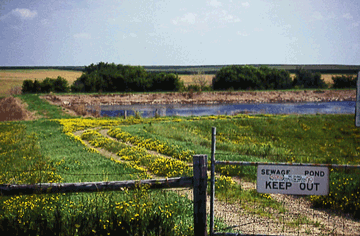 |
|
| Wastewater treatment facilities introduce contaminants such as nutrients and chloride to streams. (Photograph by Scott Murray Photography.) |
Suspended sediment adversely affects aquatic life by limiting light and covering habitat. Suspended sediment also transports nutrients, trace elements, and organic compounds attached to particles. The greatest concentration of suspended sediment in the large rivers was in the Minnesota River (Kroening, 2000). The primary contributors of suspended sediment to the Minnesota River are the tributary watersheds in the central and southeastern parts of the Minnesota River Basin (Payne, 1994). Concentrations were lower in the St. Croix River and in the upper reaches of the Mississippi River.
Pesticides frequently were detected in the large rivers, but no concentrations exceeded applicable drinking-water standards or guidelines (Fallon and others, 1997; Fallon, 1998). Herbicides detected in all large rivers include the row crop herbicides alachlor, atrazine, and its degradation product deethylatrazine, cyanazine, and metolachlor. In and downstream from the TCMA, insecticides were frequently detected in water, and although use was discontinued in the early 1970s, DDT and its degradation products DDE and DDD were frequently detected in fish tissue and bed sediment.
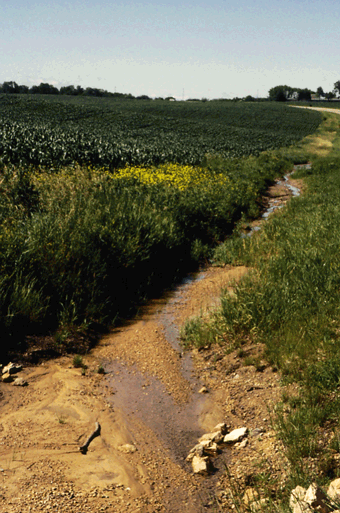 |
| The runoff of agricultural chemicals and sediment affects water quality in nearby streams and rivers. (Photograph by Scott Murray Photography.) |
Streambed sediment in the Mississippi River within and downstream from the TCMA contained the greatest number of OCs (Fallon and others, 1997; Fallon, 1998). PCB concentrations in streambed sediments have decreased over time (Anderson and Perry, 1999). Fish tissue concentrations have paralleled this decline (Lee and Anderson, 1998).
Human activities have had a strong influence on the occurrence and distribution of trace elements in large rivers of the Study Unit. The TCMA is the largest source of trace elements to rivers in the Study Unit. Trace-element data collected in the TCMA during 1992 by the Metropolitan Waste Control Commission (1994) indicate that concentrations of most trace elements in the water were less than applicable standards and guidelines, with the periodic exceptions of mercury and copper. Concentrations of cadmium, lead, mercury, and zinc were greatest in streambed-sediment samples within or immediately downstream from the TCMA (Wiener and others, 1984; Kroening and others, 2000). An industrial pretreatment program that began in the early 1980s has reduced the amount of trace elements discharged to the Mississippi River. For example, zinc concentrations have decreased an average of 80 percent (Anderson and Perry, 1999) (fig. 21) since the pretreatment program began.
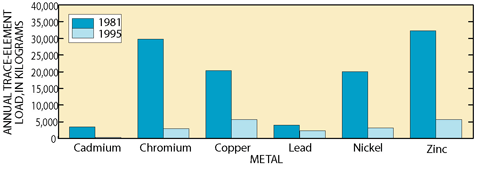 |
| Figure 21. Annual trace-element load from the Metropolitan Wastewater Treatment Plant by industrial users has decreased since 1981. |
Treated wastewater and untreated animal waste in the Study Unit also contribute to increased counts of fecal bacteria in the large rivers. Fecal bacteria counts were greatest in the Minnesota River and in the Mississippi River as it flowed through the TCMA. Approximately 40 percent of samples collected in the Minnesota River Basin exceeded the Minnesota and Wisconsin State freshwater standards for recreational use of 200 col/100 mL (Payne, 1994; Wisconsin Department of Natural Resources, 1997; Minnesota Pollution Control Agency, 1999). Data collected by the Metropolitan Waste Control Commission (1994) indicate that during 1992, 25 percent of the water samples collected in the Mississippi River immediately downstream from the Minnesota River and the Metropolitan Wastewater Treatment Plant outfall exceeded freshwater standards for recreational use regarding bacteria.
Changes in the habitat of the large rivers have been caused by the construction of locks and dams, dredging to maintain navigation channels, modifications to stream morphology, and changes in land use. (see “Riparian Buffer Zones Affect the Quality of Midwestern Streams and Rivers,” p. 9). Instream habitat and fish community conditions in the large rivers differ among areas of forest, urban, and agricultural lands. Diverse aquatic biological communities and relatively undisturbed riffle-pool morphology are found in the St. Croix River and the upper reaches of the Mississippi River in forested areas. Drainage of wetlands, loss of riparian vegetation, and channel straightening in the Minnesota River Basin have reduced habitat, modified hydraulic conditions, and changed water quality.
In the Mississippi River, the construction and maintenance of locks and dams have altered physical habitat for fish, invertebrates, and algae by changing streamflow from free-flowing to impounded, and altering the natural hydrology and the physical structure of the channel. As a result, the river has changed from a meandering, flowing system, which periodically overran its banks and flood plain, to a series of impoundments connected by dredged channels where the streamflow and water levels are controlled. The impoundments change the physical structure of the river, the diversity of aquatic habitats, and water quality. Impoundments reduce the velocity and warm the water in the pools. Reduced velocity causes sediment to settle, changing the composition of the substrate on the bottom of impoundments to fine-grained material (sand and silt). Nutrients and contaminants associated with sediment particles are concentrated in the bottom sediments of the pools.
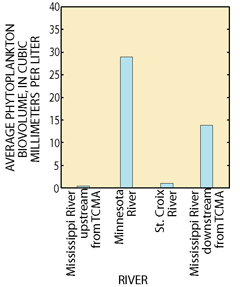 |
| Figure 22. Phytoplankton biovolume was least in the Mississippi River upstream from the Twin Cities Metropolitan Area (TCMA) and was greatest in the Minnesota River. |
The addition of nutrients from wastewater treatment facilities and from agricultural activities, combined with greater water temperatures and greater light penetration, stimulate algal growth. Concentrations of chlorophyll-a and phyto-plankton biovolume in the Minnesota River at Jordan, Minn., and in the lower Mississippi River sites at Hastings, Minn., and at Red Wing, Minn., are greater than twice the concentrations measured at the upper Mississippi River site at Royalton, Minn. (Kroening, 2000), indicating greater phytoplankton abundance and primary production (fig. 22). High concentrations of nutrients, coupled with the environmental conditions of sufficient light and temperature, can result in eutrophication and subsequent oxygen deficits. Blue-green algal blooms were suspected of causing low dissolved-oxygen concentrations in Lake Pepin during the summer of 1988 (an abnormally dry period) that resulted in fishkills (Minnesota Pollution Control Agency, 1989).
Invertebrate communities also have been influenced by environmental and morphologic conditions in the large rivers of the Study Unit. Sensitive invertebrate species (mayflies, stoneflies, and caddisflies) were most abundant in the St. Croix River, which drains primarily forested land. These sensitive taxa were least abundant in and downstream from the TCMA (fig. 23), where tolerant taxa such as Diptera (true flies) and Oligochaeta (aquatic worms) composed a large portion of the invertebrate community. Several species of mollusks are no longer present, due to commercial harvesting, loss and modification of habitat, water contamination, deposition of silt, and the introduction of zebra mussels (Mueller, 1993). Contaminants such as cadmium and mercury in the sediments have accumulated in burrowing mayflies and may present a substantial source of trace element contaminants to fish, particularly in Lake Pepin (Beauvais and others, 1995).
Several chemical and physical factors affect the abundance and distribution of fish species. St. Anthony Falls in Minneapolis, Minn., on the Mississippi River, and the dam at St. Croix Falls, Wis., on the St. Croix River, form two major barriers to fish migration. These barriers have resulted in differences in fish species composition (Underhill, 1989). More species occur downstream of the barriers (fig. 24) (Goldstein and others, 1999; Underhill, 1989).
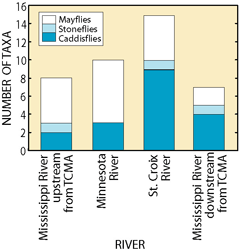 |
| Figure 23. Total number of mayflies, stoneflies, and caddisflies was least downstream from the Twin Cities Metropolitan Area (TCMA) and greatest in the St. Croix River. |
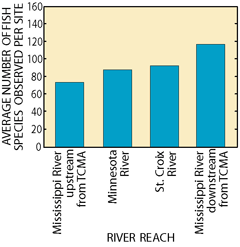 |
| Figure 24. Total number of fishspecies was greatest in the Lower Mississippi River downstream from the Twin Cities Metropolitan Area (TCMA). |
Other differences in the fish community distribution exist among large rivers in the Study Unit. The Mississippi River upstream from the TCMA and the St. Croix River upstream from Taylors Falls have fish species that thrive in cold water. Fish communities at these river sections are dominated by cool water and riverine species such as redhorse and smallmouth bass. Farther downstream, particularly in the Mississippi River downstream from the TCMA, the fish community consists of catfish, buffalo fish, freshwater drum, carpsuckers, and gizzard shad that tolerate warm water. The pattern of thermal preference is also consistent in the Minnesota and St. Croix Rivers. Lake species that are adapted to still water with high thermal ranges are found in and downstream from the TCMA.
The distribution of fish also differs by trophic status in the large rivers. Upstream from the TCMA, fish (northern hogsucker, golden and shorthead redhorse, hornyhead chub, common shiner, smallmouth bass, and two species of darter) that primarily consume invertebrates species that require a gravel or cobble substrate were abundant compared to downstream from the TCMA where fish (common carp and buffalo fish) that primarily consume detritus were more abundant. Downstream from the TCMA, species that feed on detritus rely on filter feeding and suctioning of the bottom sediments for fine particulate organic matter.
 |
| Clean drinking water is important to everyone. (Photograph from U.S. Geological Survey files.) |
The reduction in river velocity resulting from hydrologic modifications, such as impoundments, also alters the composition of the fish communities in the rivers. Species downstream from the TCMA tend to be associated with still-water habitats, whereas species upstream from the TCMA are associated more with flowing-water habitat. The abundance of fish (gizzard shad and emerald shiner) that eat plankton in the Mississippi River downstream from the TCMA indicates that a plankton community more common to lakes exists in that part of the river.
An indicator of the general quality of aquatic resources is the presence of contaminants in fish. Two contaminants, PCBs and DDE (a degradation product of DDT), were the most frequently detected OCs in fish in the Study Unit. These contaminants in fish were greatest in the Mississippi River downstream from the TCMA. PCB and DDE concentrations in common carp tissue generally were greater in the Mississippi than in the Minnesota or St. Croix Rivers, and DDE concentrations generally increased in the Mississippi River main stem from Grand Rapids, Minn., downstream to Red Wing, Minn. Although concentrations have decreased over time (Lee and Anderson, 1998), PCBs and DDE continue to be detected in fish tissue, but at relatively low concentrations of less than 1 µg/kg (micrograms per kilogram).
| Table of Contents || Previous Section || Next Section || Glossary U.S. Geological Survey Circular 1211 Suggested citation:
|


